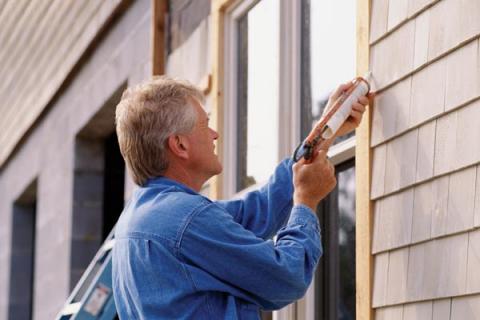
WEATHERPROOF YOUR HOME BEFORE THE WEATHER TURNS COLD
You may be trying to forget about the harsh winter of a few months ago, but you probably remember your high heating bills. Well, now’s the time to insulate yourself from a similar fate – with next winter not all that far away.
“Exterior caulk and insulation can provide a formidable defense against the cold,” says Debbie Zimmer, spokesperson for the Paint Quality Institute. “By using these products to seal cracks and openings in the home exterior, you can save a small fortune on heating cost, and on the cost of air-conditioning as well.”
Caulk and insulation work in two ways to add comfort to a home: first, they stop outside air from seeping in (or literally blowing in on windy days); second, they keep costly heat and air-conditioning from escaping. This one-two punch is a powerful way to knock down home energy bills.
If you’re in the mood to fight spiraling energy costs, begin by doing a walk-around inspection of your home exterior.
Keep an eye out for cracks, gaps, or holes – especially where different surfaces meet, or where pipes, vents, or wiring penetrate the walls. Also look for areas where your old caulk may have cracked, or pulled away from the surface. Every one of these areas is a potential energy sieve. . .and prime real estate for your caulk or insulation!
If the old caulk is damaged or deficient, remove it with a scraper or sturdy putty knife. In these areas, and in areas that are totally devoid of caulk, clean the adjacent surfaces, sand them smooth, and spot-prime if any bare wood shows. This will help your caulk adhere properly to create a weather-tight seal.
When applying your new caulk, be sure to use a top quality product – either a water-based all-acrylic, or siliconized acrylic caulk (similarly named “silicone” caulks cannot be painted, so they’ll be more visible on your home exterior).
With a loaded caulk gun in hand, work your way around your house, filling every gap or seam with a generous bead of caulk (this is not the time to be “penny-wise”, or you’ll look foolish when your heating bills arrive).
Immediately after applying the caulk, “tool” it by running a wet finger over the full length of the bead, using a slight amount of pressure. This will ensure that the caulk fills the entire gap and makes good contact with the adjacent surfaces.
Openings that are too large to caulk – typically, spaces more than ¼” wide – should be filled with a polyurethane foam insulation product. Unlike caulk, which shrinks slightly as it dries, some types of polyurethane foam actually expand after being applied. So, this type of insulation is ideal when filling large openings and cavities.
After sealing every opening you see, take a break. Then, do one last walk-around to make sure you haven’t missed anything. Often, you’ll spot a few areas that still need attention.
Put the finishing touches on your work and put your tools away. When winter comes, you’ll be happy you put in the time to weatherproof your home!
For more information on caulking, paints, and coatings visit blog.paintquality.com or www.paintquality.com.